Related Research Articles
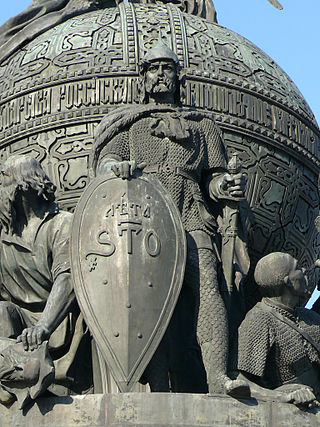
Rurik was a semi-legendary Varangian chieftain of the Rus' who, according to tradition, was invited to reign in Novgorod in the year 862. According to the Primary Chronicle, Rurik was succeeded by his kinsman Oleg who was regent for his infant son Igor.
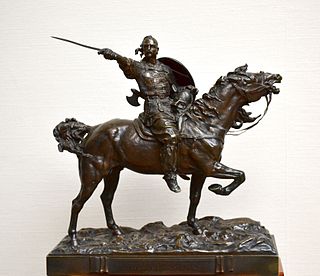
Sviatoslav or Syatoslav I Igorevich was Grand Prince of Kiev known for his persistent campaigns in the east and south, which precipitated the collapse of two great powers of Eastern Europe, Khazaria and the First Bulgarian Empire. He conquered numerous East Slavic tribes, defeated the Alans and attacked the Volga Bulgars, and at times was allied with the Pechenegs and Magyars (Hungarians).

The Primary Chronicle or Russian Primary Chronicle, is a chronicle of Kievan Rus' from about 850 to 1110. It is believed to have been originally compiled in or around Kiev in the 1110s, and has been traditionally ascribed to the monk Nestor.
The Grand Prince of Kiev was the title of the monarch of Kievan Rus', residing in Kiev from the 10th to 13th centuries. In the 13th century, Kiev became an appanage principality first of the grand prince of Vladimir and the Mongol Golden Horde governors, and later was taken over by the Grand Duchy of Lithuania.

Oleg, known as Oleg the Wise, Oleg of Novgorod, or Oleg of Kiev, was a Varangian prince of the Rus' who became the first prince of Kiev, thereby laying the foundations of the Kievan Rus' state.

Igor Rurikovich was a Rurikid ruler of Kievan Rus' from 912 to 945.

Askold and Dir, mentioned in both the Primary Chronicle the Novgorod First Chronicle and the Nikon Chronicle, were the earliest known purportedly Norse rulers of Kiev.
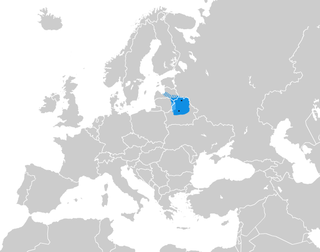
The Principality of Polotsk, also known as the Duchy of Polotsk or Polotskian Rus', was a medieval principality of the Early East Slavs. The origin and date of state establishment is uncertain. Chronicles of Kievan Rus' mention Polotsk being conquered by Vladimir the Great, and thereafter it became associated with Kievan Rus' and its ruling Rurik dynasty.

Gostomysl is a legendary 9th-century prince or posadnik of Novgorod who was introduced into the historiography by Vasily Tatishchev, an 18th-century historian. Gostomysl's rule is associated with the confederation of Northern tribes, which was formed to counter the Varangian threat in the mid-9th century and embraced the Ilmen Slavs, Krivichs, Merya, and Chud. Sergey Platonov and Aleksey Shakhmatov believed that the capital of the confederation was in modern Russa and Gostomysl could have been one of its leaders.
Sveneld is a semi-legendary 10th-century Varangian warlord in the service of Sviatoslav I and his family. Although he seems to have been the richest and the most influential Rus' leader after the ruling prince, his relation to the House of Rurik, if it existed, has not been positively established. Most of information about Sveneld is scarce.

The Novgorod First Chronicle or The Chronicle of Novgorod, 1016–1471 is the oldest extant Rus' chronicle of the Novgorod Republic. Written in Old East Slavic, it reflects a literary tradition about Kievan Rus' which differs from the Primary Chronicle. The later editions of the chronicle reflect the lost Primary Kievan Code of the late 11th century, which contained information not present in the later Primary Chronicle.
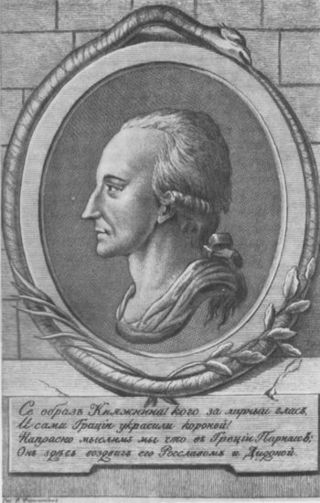
Yakov Borisovich Knyazhnin was Russia's foremost tragic author during the reign of Catherine the Great. Knyazhnin's contemporaries hailed him as the true successor to his father-in-law Alexander Sumarokov, but posterity, in the words of Vladimir Nabokov, tended to view his tragedies and comedies as "awkwardly imitated from more or less worthless French models".
Rusʹ Khaganate, or kaganate of Rus is a name applied by some modern historians to a polity postulated to have existed during a poorly documented period in the history of Eastern Europe between c. 830 and the 890s.

Kievan Rus', also known as Kyivan Rus', was a state and later an amalgam of principalities in Eastern and Northern Europe from the late 9th to the mid-13th century. Encompassing a variety of polities and peoples, including East Slavic, Norse, and Finnic, it was ruled by the Rurik dynasty, founded by the Varangian prince Rurik. The modern nations of Belarus, Russia, and Ukraine all claim Kievan Rus' as their cultural ancestor, with Belarus and Russia deriving their names from it. At its greatest extent in the mid-11th century, Kievan Rus' stretched from the White Sea in the north to the Black Sea in the south and from the headwaters of the Vistula in the west to the Taman Peninsula in the east, uniting the East Slavic tribes.

The Varangians were Viking conquerors, traders and settlers, mostly from present-day Sweden. The Varangians settled in the territories of modern-day Belarus, Russia and Ukraine, and in the 9th century, they founded the medieval state of Kievan Rus'. They also formed the Byzantine Varangian Guard, which later also included Anglo-Saxons.

The Rurikids or Riurikids also known as the Volodimerovichi, were a noble house allegedly founded by the Varangian prince Rurik, who, according to tradition, established himself in Novgorod around the year AD 862. After the conquest of Kiev by Rurik's successor Oleg the Wise in c. 880, the Rurikids established a dynasty over the state of Kievan Rus' until its disintegration in the 12th and 13th centuries. Over time, the reigning house split into many different branches, with distinct branches ruling regional centers. They continued to rule in many of the Rus' principalities which evolved out of Kievan Rus'.

Veliky Novgorod, also known as Novgorod (Новгород), is the largest city and administrative centre of Novgorod Oblast, Russia. It is one of the oldest cities in Russia, being first mentioned in the 9th century. The city lies along the Volkhov River just downstream from its outflow from Lake Ilmen and is situated on the M10 federal highway connecting Moscow and Saint Petersburg. UNESCO recognized Novgorod as a World Heritage Site in 1992. The city has a population of 224,286 (2021 Census).

Novgorodian Land was one of the largest historical territorial–state formations in Russia, covering its northwest and north. Novgorod Land, centered in Veliky Novgorod, was in the cradle of Kievan Rus' under the rule of the Rurikovich dynasty and one of the most important princely thrones of the era. During the collapse of Kievan Rus' and in subsequent centuries, Novgorod Land developed as the Novgorod Republic: an autonomous state with republican forms of government under the suzerainty of the great princes of Vladimir-Suzdal. During the period of greatest development, it reached north to the White Sea, and in the east it spread beyond the Ural Mountains. It had extensive trade relations within the framework of the Hanseatic League and with the rest of Rus'. Muscovy conquered the Novgorod Republic in 1478, and annexed it in 1578, although Novgorod Land continued to exist as an administrative unit until 1708.
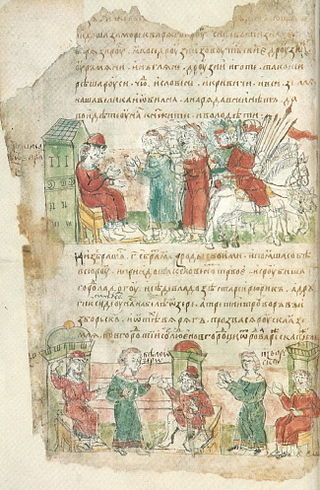
The calling of the Varangians, calling of the (Varangian) princes or invitation to the Varangians is a legend about the origins of the Rus' people, the Rurik dynasty and the Kievan Rus' state, recorded in many divergent versions in various manuscripts and compilations of Rus' chronicles. These include the six main witnesses of the Primary Chronicle and the Novgorod First Chronicle (NPL), as well as later textual witnesses such as the Sofia First Chronicle and the Pskov Third Chronicle.
References
- ↑ "Vadim of Novgorod": The tragedy in verse in five acts. (Russian). The project "Collection of classics" Libraries Moshkova (Lib.ru / Classical). Accessed May 2011.